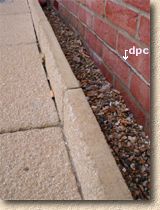Hello - first timer question. I'd really appreciate your help.
I recently bought a Edwardian house (1906, cavity walls), and am slowly getting my head around the nuances of looking after an older property. The ground levels around the house are quite high and, in places, encroach upon the DPC. At the front of the house, the ground (in flower beds, which I have now dug up) exceeded the engineering brick course. However, the property has a plinth at the base of the wall (as can be seen in the pics). I am unsure if the plinth effectively acts as an 'extended DPC layer', and hence ground level can exceed the visible engineering brick. I'd appreciate it anyone could clarify this for me!
If the plinth is not part of the damp proofing of the wall, I presumably need to construct a channel to keep the ground 75mm to 150mm (ideally) below the engineering brick. The challenge is that this would be significantly below the level of the driveway. Presumably a linear drain / French drain-type setup. I'd appreciate suggestions.
Thanks in advance!



